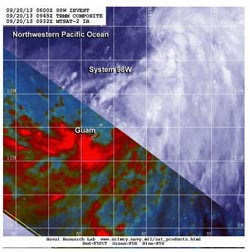TRMM satellite sees system 98W organizing near Guam, Marianas

NASA's TRMM satellite data was combined with infrared imagery from Japan's MTSAT-2 to provide a better picture of the low pressure area and showed that heavy rainfall was occurring over Guam at 0945 UTC.<br><br>Credit: NRL/NASA/JAXA<br>
At 1700 UTC/1 p.m. EDT on Sept. 20, System 98W was centered about 16.2 north and 146.7 east, about 195 nautical miles north-northeast of Andersen Air Force Base, Guam. System 98W had maximum sustained winds near 25 knots/28.7 mph/46.3 kph.
NASA's Tropical Rainfall Measuring Mission satellite called TRMM passed over System 98W earlier in the day and observed its rainfall.
At the Naval Research Laboratory, NASA's TRMM satellite data was combined with infrared imagery from Japan's MTSAT-2 to provide a better picture of the low pressure area. The TRMM data showed that heavy rainfall was occurring over Guam at 0945 UTC/5:45 a.m. EDT.
Later on Sept. 20, at 3 p.m. EDT, Guam International Airport was still reporting heavy rain, and fog/mist and a temperature of 79F. Winds were blowing from the southwest at 14 mph/22.5 kph, gusting to 18 mph/28/9.
Infrared satellite imagery showed strong convection northeast of the center of circulation and convective banding of thunderstorms southwest of the center. Those thunderstorms in the southwestern bands were affecting Guam.
The Joint Typhoon Warning Center noted that strong vertical wind shear is appearing in the upper-levels of the atmosphere near System 98W. In fact, northeasterly winds are blowing at 30 knots/34.5 mph/55.5 kph. Wind shear can weaken a storm and even tear it apart, and there's even moderate wind shear of up to 20 knots/23 mph/37 kph happening in the storm's center.
The National Weather Service in Guam issued the following bulletin at 12 a.m. CHST on Saturday, Sept. 21, 2013 local time: A tropical disturbance continues to develop in the vicinity of the Marianas. Satellite and radar imagery indicate the heaviest rain associated with the tropical disturbance has shifted to the south and east of the Marianas. However…a brief heavy shower is still possible through Saturday. The latest computer models indicate that much of the weekend will be markedly drier than the past few days. The potential for heavy rainfall will return late Sunday into Monday as this system develops and moves northward. Light to gentle winds tonight will become southwest and increase to 25 to 30 mph by Saturday night as the disturbance moves northward. Offshore seas of 8 to 10 feet tonight will steadily increase to between 11 and 13 feet by Monday as southwest winds increase across the Marianas over the next few days.
Because the low-level center is consolidating the Joint Typhoon Warning Center expects System 98W to become a tropical depression in the next 24 hours. System 98W has been moving to the north and is expected to continue moving in that direction over the next two days.
Media Contact
More Information:
http://www.nasa.govAll latest news from the category: Earth Sciences
Earth Sciences (also referred to as Geosciences), which deals with basic issues surrounding our planet, plays a vital role in the area of energy and raw materials supply.
Earth Sciences comprises subjects such as geology, geography, geological informatics, paleontology, mineralogy, petrography, crystallography, geophysics, geodesy, glaciology, cartography, photogrammetry, meteorology and seismology, early-warning systems, earthquake research and polar research.
Newest articles

Recovering phosphorus from sewage sludge ash
Chemical and heat treatment of sewage sludge can recover phosphorus in a process that could help address the problem of diminishing supplies of phosphorus ores. Valuable supplies of phosphorus could…

Efficient, sustainable and cost-effective hybrid energy storage system for modern power grids
EU project HyFlow: Over three years of research, the consortium of the EU project HyFlow has successfully developed a highly efficient, sustainable, and cost-effective hybrid energy storage system (HESS) that…

After 25 years, researchers uncover genetic cause of rare neurological disease
Some families call it a trial of faith. Others just call it a curse. The progressive neurological disease known as spinocerebellar ataxia 4 (SCA4) is a rare condition, but its…





















